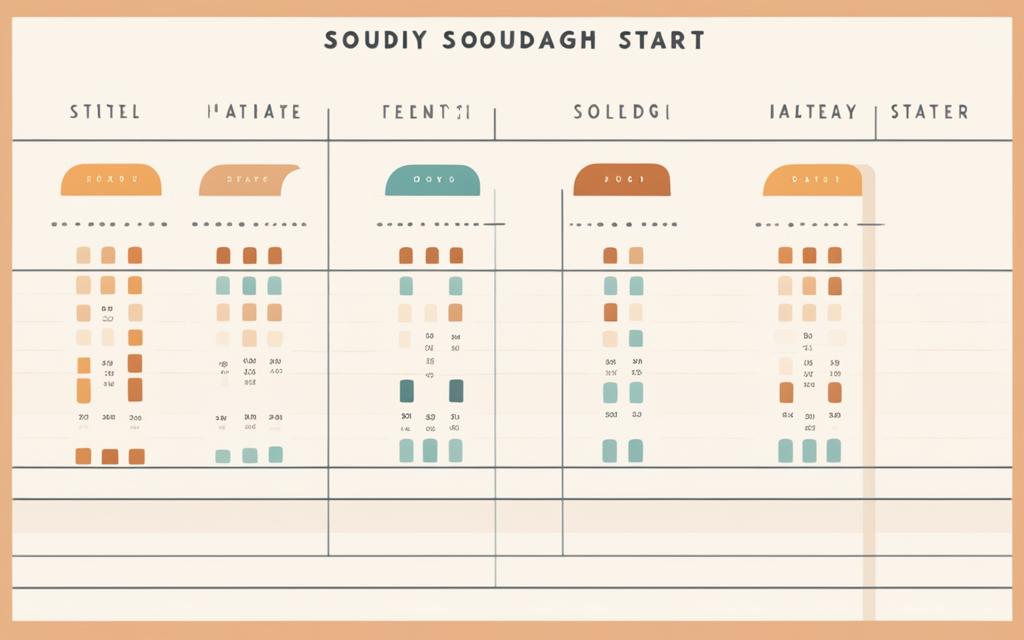Understanding the optimal feeding frequency for your sourdough starter is essential for maintaining a healthy and active culture. A well-fed sourdough starter will not only contribute to the deliciousness of your homemade bread but also ensure consistent results every time you bake. In this section, we will delve into the feeding schedule for your sourdough starter, providing you with guidance on when and how often to feed it.
Key Takeaways:
- Feeding your sourdough starter regularly is crucial for maintaining its health and activity.
- Establishing a consistent feeding schedule based on the stage of development and desired activity level is important.
- Once your sourdough starter has matured, you can adjust the feeding frequency accordingly.
- Adapting your feeding routine to fit your schedule is essential for long-term sourdough starter maintenance.
- Knowing the signs of overfeeding or underfeeding and troubleshooting common issues is crucial for a thriving starter.
Importance of Feeding Frequency
Feeding your sourdough starter regularly is crucial for maintaining its overall health and activity. Regular feeding helps to maintain the balance of yeast and bacteria, ensuring that your starter remains active and capable of leavening your dough.
When it comes to sourdough starter maintenance, consistency is key. By feeding your starter on a regular basis, you provide it with the necessary nourishment to thrive. This will result in a stronger and more stable culture, which in turn will enhance the flavor and texture of your sourdough bread.
Regular feeding also helps to prevent the growth of unwanted bacteria and mold, as the active fermentation of the starter creates an acidic environment that inhibits their development. Furthermore, feeding your starter regularly ensures that it maintains its strength and vigor, enabling it to consistently rise and create those coveted airy and light loaves of bread.
To guide you in maintaining a healthy sourdough starter, here is a simple sourdough starter feeding guide:
| Feeding Frequency | Ratio | Feeding Amount |
|---|---|---|
| Maintenance Feed | 1:1:1 | Equal parts starter, flour, and water |
| Revitalizing Feed | 1:3:3 | One part starter, three parts flour, and three parts water |
For regular maintenance, feed your sourdough starter daily or every 12 hours using the maintenance feed ratio. This ensures that your starter remains active and healthy.
Occasionally, you may need to revitalize your starter if it becomes sluggish or less active. To do this, use the revitalizing feed ratio and allow your starter to ferment at room temperature for a few hours before returning it to regular maintenance feedings.
Remember, every sourdough starter is unique, and you may need to adjust the feeding frequency based on your specific environment and schedule. Pay attention to the activity and consistency of your starter, and make adjustments as necessary to achieve the desired results.
Establishing a Feeding Schedule
Establishing a consistent feeding schedule is crucial for maintaining the vitality of your sourdough starter. The timing of feedings depends on both the stage of development and the desired activity level of your starter. By following a reliable routine, you can ensure that your starter stays robust and ready to create delicious bread.
When determining the frequency of feeding, consider the following factors:
Stage of Development
During the initial stages of creating a sourdough starter, frequent feedings are necessary to cultivate a strong yeast and bacteria population. This typically involves daily feedings for the first week or so, until you notice consistent signs of fermentation and activity. As your starter matures, the feeding intervals can be extended.
Desired Activity Level
If you prefer a more active starter that rises quickly, you may opt for more frequent feedings. This helps maintain a higher population of yeast and bacteria, promoting faster fermentation. On the other hand, if you prefer a milder flavor profile or need to slow down the fermentation process, less frequent feedings can be implemented.
Ultimately, the ideal feeding schedule will vary depending on your personal preferences and baking needs. It may take some experimentation to find the perfect balance, but consistency is key. Keeping a feeding log can be helpful in tracking the performance of your starter and making adjustments as needed.
Sample Feeding Schedule for a Mature Starter
Once your sourdough starter has matured and is regularly active, you can adjust the feeding frequency. Here’s a sample feeding schedule that you can follow as a starting point:
| Days since Previous Feeding | Feeding Action |
|---|---|
| 24 hours | Discard all but 50g of starter |
| 24 hours | Feed with 50g flour and 50g water |
| 24 hours | Repeat the previous feeding action |
| 24 hours | Repeat the previous feeding action |
Note: This schedule assumes a 100% hydration starter, which means equal amounts of flour and water by weight. Adjust the quantities based on the hydration of your starter.
By adhering to a consistent feeding schedule and monitoring the performance of your sourdough starter, you can maintain its health and ensure optimal baking results. In the next section, we will discuss how to adapt your feeding routine to suit your schedule and troubleshoot any issues that may arise.
Frequency for a Mature Starter
Once your sourdough starter has matured and is regularly active, it’s important to adjust the feeding frequency to ensure its continued health and optimal performance. By understanding the right care and feeding tips, you can keep your mature starter in peak condition.
Recommended Feeding Frequency
For a mature sourdough starter, feeding it once or twice a day is generally sufficient to maintain its activity level. However, the exact frequency may vary depending on the specific characteristics of your starter and the ambient temperature in your kitchen.
When determining the feeding frequency, it’s crucial to observe the signs of your starter’s activity. A healthy starter will rise and fall predictably between feedings, indicating that it is still active and responsive. If you notice that your starter is taking longer to rise or losing its vigor, it may be a sign that it requires more frequent feedings.
On the other hand, if your starter is regularly peaking and falling within 8 to 12 hours, it is likely thriving and can handle longer intervals between feedings. Adjusting the frequency based on careful observation will help you strike the right balance and maintain a healthy, robust starter.
Maintaining Optimal Conditions
In addition to adjusting the feeding frequency, there are several other considerations to keep in mind when caring for a mature sourdough starter. These include:
| Tip | Description |
|---|---|
| Temperature | Maintain a consistent temperature between 70-85°F (21-29°C) to optimize the activity of your starter. |
| Feeding Ratio | Use a 1:1:1 or 1:2:2 ratio of starter, flour, and water during feedings to ensure a balanced and nutritious diet for your starter. |
| Hydration Level | Adjust the hydration level of your starter by altering the water-to-flour ratio to achieve the desired consistency and performance. |
| Storage | Keep your mature starter in a covered container in the refrigerator when not actively feeding or baking with it. |
| Freshening | To revitalize a mature starter that has been neglected or stored for a long time, consider discarding a portion and refreshing it with fresh flour and water. |
By following these sourdough starter care and feeding tips, you can ensure that your mature starter remains active, healthy, and ready to leaven your delicious homemade bread.

Adapting to Your Schedule
Life can be busy, and finding the right feeding schedule for your sourdough starter is essential to maintaining its long-term health. Here are some strategies to help you adapt your sourdough feeding routine to fit your busy schedule:
1. Choose a Feeding Frequency
Assessing the frequency at which you can realistically feed your sourdough starter is the first step in adapting to your schedule. Consider your availability and commitments to determine whether you can feed your starter daily, every other day, or even on a weekly basis.
2. Adjust Starter Quantity
If you have limited time for feeding, consider reducing the quantity of sourdough starter you maintain. This will reduce the amount of time and effort required for feeding and discarding excess starter.
3. Experiment with Temperature
Temperature plays a crucial role in the fermentation process of sourdough. By adjusting the temperature, you can slow down or speed up the feeding process. Experiment with different temperatures to find what works best for you. However, avoid extreme temperature fluctuations, as they can impact the health of your starter.
4. Use Refrigeration
If your schedule doesn’t allow for frequent feeding, consider storing your sourdough starter in the refrigerator. Refrigeration slows down the fermentation process, allowing you to feed your starter less frequently. Before using a refrigerated starter, be sure to refresh it with a few feedings at room temperature to reactivate its activity.
5. Create a Feeding Schedule
| Feeding Schedule | Feeding Frequency | Temperature |
|---|---|---|
| Morning Feeder | Every morning | Room temperature |
| Evening Feeder | Every evening | Room temperature |
| Weekend Warrior | Once a week | Room temperature |
| Chiller | Every 3 days | Refrigerated |
Table: Adapted Feeding Schedules for Different Routines
Remember, the key to maintaining a healthy sourdough starter is consistency. Once you establish a feeding schedule that works for you, stick to it as closely as possible. Consistency will help ensure that your sourdough starter remains active and healthy, even with a busy schedule.
Signs of Overfeeding or Underfeeding
When it comes to maintaining a healthy sourdough starter, knowing the signs of overfeeding or underfeeding is essential. These signs can help you troubleshoot any issues that may arise and make the necessary adjustments to your feeding schedule. Let’s take a look at some common symptoms and how to address them:
Signs of Overfeeding
Overfeeding your sourdough starter can lead to excessive acidity and sluggishness. Here are a few signs that indicate you may be overfeeding:
| Signs of Overfeeding | Causes | How to Adjust |
|---|---|---|
| The starter is very sour and tangy | Feeding too much too frequently | Reduce the feeding amount and frequency |
| The starter has a thick, hooch layer | Not discarding enough before feeding | Increase the discard amount during feedings |
| The starter rises quickly but deflates soon after | High yeast activity, resulting in quick fermentation | Adjust the feeding ratio to balance yeast and bacteria |
Signs of Underfeeding
On the other hand, underfeeding your sourdough starter can cause it to become sluggish and weak. Keep an eye out for these signs of underfeeding:
| Signs of Underfeeding | Causes | How to Adjust |
|---|---|---|
| The starter shows minimal activity | Infrequent or inadequate feedings | Increase the feeding frequency and amount |
| The starter takes a long time to rise | Lack of yeast activity | Adjust the feeding ratio to promote yeast growth |
| The starter has a weak, unpleasant smell | Insufficient food for the bacteria | Increase the feeding ratio to support bacterial growth |
By paying attention to these signs and making the necessary adjustments, you can ensure that your sourdough starter remains healthy and active. Remember, maintaining the right balance is key to achieving optimal results in your sourdough baking.
Troubleshooting Common Issues
Sometimes, despite your best efforts, issues may arise with your sourdough starter. It’s important to identify and address these problems promptly to ensure the continued care and feeding of your starter. In this section, we will cover common issues such as sluggishness or excessive acidity and provide troubleshooting tips to help you rectify these issues.
Sluggishness
If your sourdough starter is sluggish and not rising as expected, there are several possible causes. One common reason is underfeeding. Make sure you are maintaining a consistent feeding schedule and providing enough food for your starter. Additionally, consider the temperature in which your starter is being kept. Cooler temperatures can slow down fermentation, while warmer temperatures can speed it up. Adjusting the temperature may help revive a sluggish starter.
Excessive Acidity
Excessive acidity in your sourdough starter can result in a sour or overly tangy flavor. This can be caused by overfeeding or allowing the starter to sit for too long without feeding. To address excessive acidity, try adjusting your feeding schedule to feed your starter less frequently. You can also reduce the amount of starter you keep or increase the feeding ratio to dilute the acidity.
Other Issues
While sluggishness and excessive acidity are common issues with sourdough starters, other problems may arise as well. These can include mold growth, unusual smells, or discoloration. If you encounter any of these issues, it’s best to discard your starter and begin anew. Starting with a fresh culture can help ensure a healthy and active sourdough starter.
Remember, troubleshooting sourdough starter issues requires a bit of experimentation and observation. By closely monitoring your starter’s behavior and making adjustments as needed, you can overcome common issues and maintain a healthy sourdough culture.
Conclusion
In this comprehensive guide, we have explored the optimal feeding frequency for a healthy sourdough starter. By understanding the importance of regular feeding, establishing a feeding schedule, and adapting to your own needs, you can confidently maintain a thriving sourdough culture.
Observing the signs of overfeeding or underfeeding and troubleshooting any issues promptly is crucial for the long-term health of your starter. With the right care and attention, you’ll be on your way to creating delicious sourdough bread for years to come.
Remember, maintaining a sourdough starter is a journey that requires patience and experimentation. While this guide provides a solid foundation, don’t be afraid to adjust your feeding schedule and methods as you gain more experience. Each sourdough culture is unique, so embrace the process and enjoy the rewarding results of your homemade sourdough bread.



